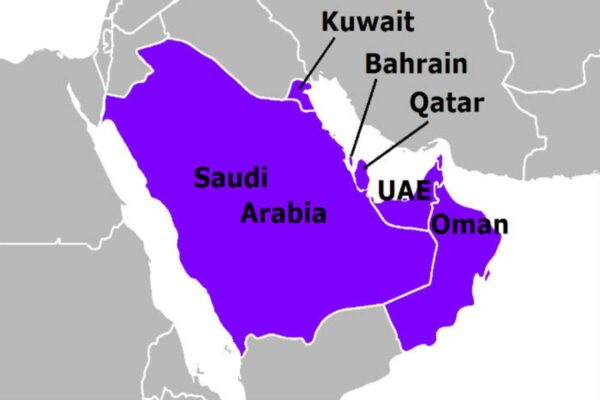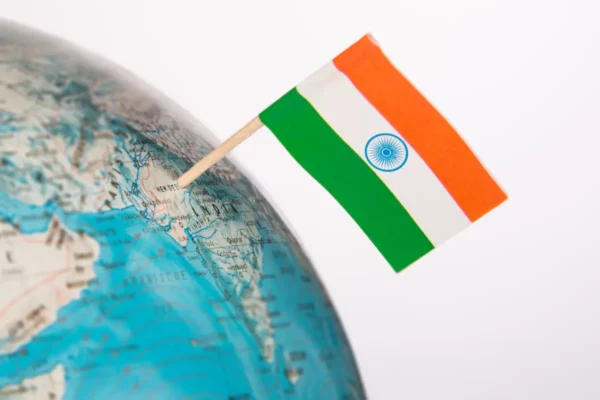India-GCC bilateral trade witnesses rapid expansion 2021-22

Due to growing economic relations between the India-GCC, India’s bilateral trade with all six members of the GCC (Gulf Cooperation Council) group countries, including the UAE and Saudi Arabia, rose significantly in 2021-22. According to figures from the commerce ministry, India’s exports to the GCC climbed by 58.26% to USD 44 billion in 2021-22, up from USD 27.8 billion in 2020-21.
These six countries account for 10.4 per cent of India’s total exports in 2021-22, up from 9.51 per cent in 2020-21. Similarly, imports increased by 85.8% to USD 110.73 billion from USD 59.6 billion in 2020-21. GCC members’ proportion of India’s total imports rose to 18% in 2021-22 from 15.5% in 2020-21.
From USD 87.4 billion in 2020-21 to USD 154.73 billion in 2021-22, bilateral trade has climbed to USD 154.73 billion. These rising numbers are significant since India is negotiating a free trade agreement with the organization.
On May 1, the country signed a comprehensive trade agreement with the UAE to increase bilateral commerce to USD 100 billion in the following years.
The GCC was founded in May of 1981. Saudi Arabia, Bahrain, Kuwait, Oman, Qatar, and the United Arab Emirates are its members.
Sharad Kumar Saraf, a Mumbai-based exporter and founder chairman of Techno-craft Industries India, said the GCC has emerged as a major commercial partner for India, with significant potential for further investment between the two areas.
“In the following years, the commercial relationship will only get stronger. Anti-China sentiments, rising domestic product quality, and improved international trade contribute to the increase. It will be a quantum leap when the trade treaty is effectively operationalized, “Saraf explained.
Another industry analyst stated that the GCC’s vast oil and gas reserves are critical for India’s energy needs and that India can help the GCC achieve its food security demands.
Here’s a breakdown of India’s bilateral trade with the Gulf states: India imports crude oil and natural gas mainly from Gulf countries such as Saudi Arabia and Qatar, and exports pearls, precious and semi-precious stones, metals, imitation jewellery, electrical machinery, iron and steel, and chemicals to these states.
India bought commodities worth USD 110.73 billion from the GCC (Gulf Cooperation Council) countries in 2020-21. Its merchandise exports to these countries totalled USD 44 billion.
The Gulf countries are home to a sizable Indian community, apart from trade. Nearly half of India’s 32 million non-resident Indians (NRIs) are employed in Gulf countries. This NRIs pay a substantial quantity of money back to their home countries.
According to a World Bank study published in November 2021, India received USD 87 billion in overseas remittances 2021. A significant amount of this comes from the GCC countries.
Trade between India-GCC
- India and Saudi Arabia have a cordial bilateral relationship right after the oil boom in the mid-1970s. Saudi Arabia was the fourth-largest trading partner in the previous fiscal year. Total bilateral trade grew to USD 43 billion in 2021-22, up from USD 22 billion the last fiscal year. Both sides also aim to diversify their oil-based- economy to manufacturing, tourism, and technology.
- Qatar: India receives 8.5 million tonnes of LNG from Qatar each year and exports various goods, including grains, meat, fish, chemicals, and plastics. India-Qatar trade increased to USD 15 billion in 2021-22, up from USD 9.21 billion in 2020-21. India – Qatar relations are always flourishing in energy requirements, trading partnerships and investments. India is heavily dependent on Qatar for its Gas requirements. India currently imports up to 8.5 million tonnes of LNG per annum.
- Kuwait: In the previous fiscal year, it was India’s 27th largest trading partner. In 2021-22, bilateral trade increased to USD 12.3 billion, up from USD 6.3 billion the previous fiscal year. India and Kuwait both have diplomatic relations as Kuwait has a majority of emigrants from India and is the source of 10-12% of oil. India serves as the most significant partnership in Kuwait.
- UAE: In 2021-22, it was India’s third-largest commercial partner. In 2021-22, India’s bilateral trade with the country climbed to USD 72.9 billion, up from USD 43.3 billion in 2020-21. India and UAE are also strengthening their economic relations and bilateral ties. More than 3,420,000 Indian migrants reside in the UAE, which is around 27 per cent of the UAE’s total population. India and UAE are investing in various sectors other than energy.
- In 2021-22, Oman was India’s 31st most significant trading partner. In 2021-22, India’s bilateral trade will be around USD 10 billion, up from USD 5.5 billion in 2020-21. India and Oman have a solid strategic bond and are also considering the construction of a 1,100-km-long underwater natural gas pipeline from Oman. Also, Indian and Omani firms have undertaken joint ventures in various fields, including fertilizers, pharmaceuticals, energy and engineering.
- Bahrain: In 2021-22, two-way trade with India was USD 1.65 billion, up from USD 1 billion in 2020-21. These six countries lie under the Gulf cooperation council as they are the hub of oil and gas reserves on which India is highly dependent for their energy resource. Bahrain is interested in the International Solar Alliance, so India allows them to join this Alliance.

Furthermore, in 2021-22, India’s bilateral trade with Iran totalled USD 1.9 billion, down from USD 2.1 billion in 2020-21.
LET’S KNOW ABOUT GCC!
Gulf Cooperation Council (GCC) is a regional, intergovernmental, political, economic, and social organization of six Arab Gulf countries with tremendous significance for India. India’s “immediate” neighbourhood is the Gulf, separated only by the Arabian Sea. As a result, India is interested in the Gulf’s stability, security, and economic well-being.
The GCC is progressively dictating its member states’ economic, political, and security agendas. The GCC countries are making remarkable progress in integrating their economies. India’s most significant financial partner is the Gulf Cooperation Council (GCC). It has a lot of potential as a future investment partner for India. The GCC’s substantial oil and gas reserves are of utmost importance for India’s energy needs.
Today, the GCC states have 40 per cent of world oil proven reserves of 527.6 billion barrels and 23 per cent of natural gas proven resources of 1,378.7 trillion cubic feet.
The GCC states provided 21.88 million barrels per day and 425.4 billion cubic metres of natural gas to global oil production in 2019. The GCC countries collectively host a large Indian expatriate community. In summary, the GCC has enormous potential for collaboration in trade, investment, energy, and personnel.
GCC and India: Why Gulf countries are crucial for India’s economy
India’s bilateral trade with the GCC was almost $154 billion in 2021-22, with a $67 billion trade imbalance. Here’s why Gulf countries are so crucial to India’s economy.
A third of India’s oil imports come from the Gulf Cooperation Council, including Bahrain, Kuwait, Qatar, Oman, Saudi Arabia, and the United Arab Emirates (GCC). Qatar is also India’s largest LNG supplier. In other words, the GCC countries are responsible for most of India’s energy needs.
The GCC nations have accounted for roughly 65 per cent of India’s spectacular annual remittances of more than $80 billion in the last three years.
They are home to many Indian migrants, totalling approximately nine million. These countries also account for over 15% of India’s worldwide commerce. The figures clearly illustrate that the Gulf Cooperation Council countries play a significant role in India’s economy.
Among GCC countries, the UAE is India’s largest trading partner — overall, it is third after the US and China — the latest Ministry of Commerce and Industry data shows. Trade with the UAE accounts for more than seven per cent of India’s total trade. As per the latest available data for 2021-22, India exported goods and services worth $28 billion, and the import bill totalled nearly $45 billion.
Crude and natural gas account for about 60% of India’s imports from the Gulf Cooperation Council countries. On the other hand, India’s exports include finished jewellery, refined petroleum, grains, textiles, automobiles, and broadcasting equipment. Other items include diamond, gold, and polymers.
- GCC countries with large hydrocarbon reserves are crucial for India’s energy requirements. At the same time, the region has been a good market for Indian products such as foods, medicines, and other essential items.
- India’s food industry is competitive because its sizeable Muslim population exports many halal products, giving it a head start over China, trying to get into the halal export business.
- Indians are also well-represented in the GCC countries, particularly Saudi Arabia and the United Arab Emirates, as skilled and unskilled workers. About 6.5 million Indians are working in the Gulf, and many Indian companies are active in sectors like construction and technology.
- Over the last few years, the number of Indian migrant workers has decreased due to COVID 19 and the Localization process in the region. Bollywood is enormously popular among both expatriates and native Arabs in the Gulf.
- For the past four decades, India’s connection with the area has been driven by energy and the workforce.

- The India-Gulf Cooperation Council (GCC) Free Trade Agreement (FTA) is in the final stages of negotiations. The India-GCC Free Trade Agreement (FTA) has the potential to improve relations.
- Following the repeal of Article 370 and the CAA, neither the UAE nor Saudi Arabia has adopted an aggressive stance against India on these issues.
- India and GCC members are members of the Financial Action Task Force (FATF). The Gulf Cooperation Council (GCC) welcomed India’s non-permanent membership in the United Nations Security Council (UNSC) beginning in January 2021.
- India’s biggest trading partners are from the Gulf. The increased volume of energy imports into India reflects the deepening energy interdependence. There is also the possibility of significant Gulf investments in the Indian hydrocarbon sector.
- India has stayed out of local and regional conflicts because its goals do not require power projection but rather peace and regional stability.
- Hajj pilgrimage and informal relations such as educational and cultural ties are significant for both regions.
India’s Core interests in the Gulf Countries
The Gulf countries are highly significant for India as they are abundant in Oil and Gas resources. India has had strong and cordial relations with these energy-rich gulf countries since the oil boom in the 1970s.
With its sizeable demographic population, India has been exposed to a greater need for oil and gas; thus, it is heavily dependent on these gulf countries for its oil and gas needs to be met. Some core issues concerning India’s connection with Gulf countries are:
- The Gulf is the largest oil-producing region. About 34% of the total world oil production is from the Gulf countries with 45% of crude oil, and 48% of the world oil-proven reserves are there in this region. As far as India is concerned, India is highly dependent on these oil-rich countries for its oil and energy requirements meet. India is the third-largest oil consumer after the US and China and the fourth-largest LNG importer.
- To meet its oil and energy requirements, India has cordial bilateral diplomatic relations with these oil-rich countries. Saudi Arabia, Iraq and Kuwait are the crucial countries from which India’s demand of large energy requirements are fulfilled. India imports more than 60% of its oil requirement from the Gulf countries. Iraq last year became India’s leading Oil importer importing almost 46.61 million tonnes of crude oil to India from April 2018 to March 2019.
- Apart from India’s energy requirements from Gulf. The region is also crucial for India because of the Indian expatriates and India’s labours living there and the remittance they constitute to India. According to the data, almost 8.9 million workers reside there, comprising about $79 billion in remittances, half of India’s total remittances.
- The region lacks stability because of external involvement. Indeed internal conflicts such as civil wars, political instability, sectarian strife, and religious extremism, a growing number of Indian diaspora in the Gulf region is concerned with India for their security and safety due to the political instability in the area thus India practices soft power diplomacy to deal with challenges. India can pursue strategic diplomatic autonomy in the area and maintain a healthier and cordial relationship with these countries.
- India also considered Gulf as a potential source of investment and invested in Iraq, Jordan, GCC countries, and Iran in manufacturing, consumer goods and technology.
Remittances
The enormous diaspora sends money back home regularly, making India the world’s largest beneficiary of remittances. Because of the COVID-19 Pandemic and the local labour market policies to promote the nationalization of jobs, the number of Indian migrant workers decreased in the region, and it was seen a substantial drop in the remittances India receives from the GCC states that make up nearly 50 per cent of the total remittances into India.
These remittances contribute almost 3 per cent to India’s GDP. The UAE and Saudi Arabia, which have many Indian workers, are also the major remittance contributors. In recent times, about 39 US$ billion in remittances have come from the GCC countries. At the same time, it was about 49 US $ billion during 2017-2018.
India-GCC FTA
In August 2004, India and the Gulf Ties Council inked a Framework Agreement to improve and develop economic cooperation between the two countries in New Delhi.
According to sources familiar with the situation, India is expected to undertake deeper discussions with the Gulf Cooperation Council (GCC) countries as early as May-June to finalize a free trade agreement (FTA) with the group of nations.
The GCC has deferred its discussions with all governments and economic groups and is currently examining its negotiations with all countries and economic groups. There have been two rounds of talks to finalize issues such as tariff rules, rules of origin, etc. Therefore the third round has not taken place. Efforts are being made at various bilateral and international forums to resume the negotiations as soon as possible.

OVERALL
The COVID-19 Pandemic has significantly impacted bilateral ties between India and the Gulf Cooperation Council (GCC) countries. While trade relations and Indian expatriates suffered, the flow of investments from the Gulf Cooperation Council to India increased.
The cooperation and coordination in the fight against the Pandemic were necessary and positive, underlining the solid bilateral bonds. Continuity in terms of political and diplomatic contacts through digital meetings, telephonic conversations, and virtual diplomacy was notable.
India undertook concentrated efforts to rejuvenate its relations with GCC countries. It is now time for India and GCC to start looking beyond the Pandemic to develop cooperation in new and emerging areas such as healthcare and pharmaceutical industries, higher education, defence manufacturing, and other sectors and tap the infinite potential for further strengthening the bilateral relations.
Read more details on the Inventiva Website – https://www.inventiva.co.in/




